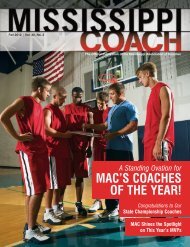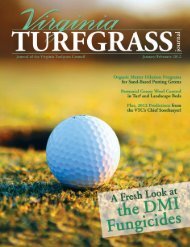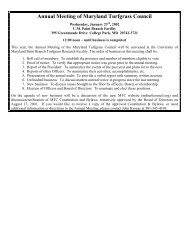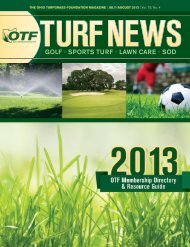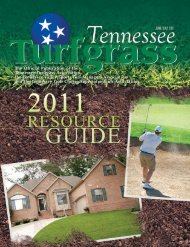the Fate of Field Paspalum Control - The Paginator
the Fate of Field Paspalum Control - The Paginator
the Fate of Field Paspalum Control - The Paginator
You also want an ePaper? Increase the reach of your titles
YUMPU automatically turns print PDFs into web optimized ePapers that Google loves.
APPLIED RESEARCH • continued<br />
Fertilizer treatments were applied in<br />
1/3 equal increments in May, September<br />
and October <strong>of</strong> each year, based<br />
on standard lawn fertilization guidelines<br />
from Minnesota Cooperative<br />
Extension. <strong>The</strong>se guidelines closely<br />
match those <strong>of</strong> Virginia Cooperative<br />
Extension. No irrigation was used on<br />
<strong>the</strong>se lawn plots. <strong>The</strong> initial soil test<br />
P level was 25 ppm; this level is in <strong>the</strong><br />
sufficiency range, so <strong>the</strong> testing lab<br />
recommended little to no P for normal<br />
lawn maintenance.<br />
What happened? By year three, <strong>the</strong><br />
no-fertilizer plots had greatly reduced<br />
turf density, greater weed density, more<br />
exposed soil and more dead grass/weed<br />
tissue than <strong>the</strong> N fertilized plots.<br />
Adding P at a 1x or 3x rate did not<br />
improve turf density relative to applying<br />
N-alone. Significantly, total P<br />
run<strong>of</strong>f from <strong>the</strong> no-fertilizer plots was<br />
greatest over <strong>the</strong> three years <strong>of</strong> monitoring<br />
because <strong>of</strong> greater run<strong>of</strong>f depth.<br />
That is, more water was lost from <strong>the</strong><br />
plots that did not receive N fertilizer<br />
because <strong>of</strong> insufficient turf cover to<br />
impede flow, especially when <strong>the</strong> soil<br />
surface was frozen. Contained within<br />
this run<strong>of</strong>f water was also a greater<br />
load <strong>of</strong> P bound to soil and leaflitter<br />
sediment.<br />
Thus, as long as enough N was<br />
applied to maintain density and retard<br />
weed invasion, less P was lost in run<strong>of</strong>f,<br />
relative to <strong>the</strong> no-fertilizer control,<br />
even when P was applied at 3 times <strong>the</strong><br />
recommended rate. I do not make this<br />
point to justify over-application <strong>of</strong> P<br />
to lawns, but merely to highlight that<br />
<strong>the</strong> controlling factor in reducing P<br />
run<strong>of</strong>f from lawns is turf density.<br />
Researchers in New York (a Chesapeake<br />
Bay state) have reported similar<br />
results. <strong>The</strong>y established an 80%<br />
Kentucky bluegrass/20% perennial<br />
ryegrass area from seed on a sandy<br />
loam soil with an 8% slope, using<br />
various natural organic and syn<strong>the</strong>tic<br />
fertilizer treatments. Once <strong>the</strong> plots<br />
were mature (year 2,) results showed<br />
that <strong>the</strong> unfertilized control plots had<br />
significantly higher P-mass losses compared<br />
to any <strong>of</strong> <strong>the</strong> fertilized plots.<br />
<strong>The</strong>se losses strongly correlated with<br />
less shoot density and lower infiltration<br />
rates on <strong>the</strong> unfertilized control plots.<br />
A direct quote is that “as shoot density<br />
doubled, <strong>the</strong> infiltration rate increased,<br />
which reduced run<strong>of</strong>f by three-fold.”<br />
<strong>The</strong> highest annual rate <strong>of</strong> fertilizer<br />
N applied in this study was moderate,<br />
at 2 lbs./1,000 ft 2 , but it was enough<br />
to ensure adequate turf density and<br />
water infiltration. Nitrate-N run<strong>of</strong>f<br />
from <strong>the</strong> organic or syn<strong>the</strong>tic fertilizer<br />
treatments did not differ from<br />
<strong>the</strong> unfertilized control, averaging<br />
between 2 to 4.5 ppm, considerably<br />
18 MTC TURF NEWS




